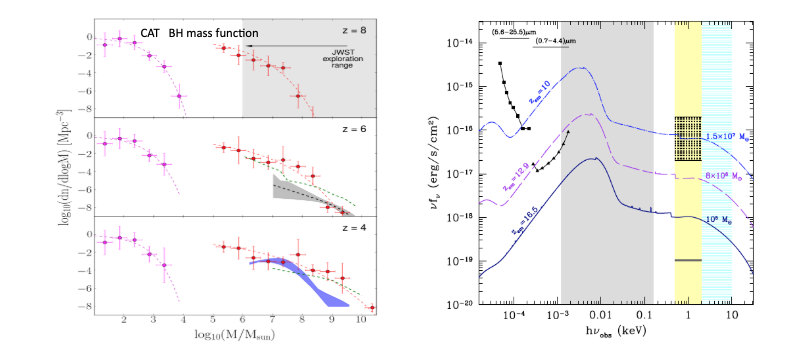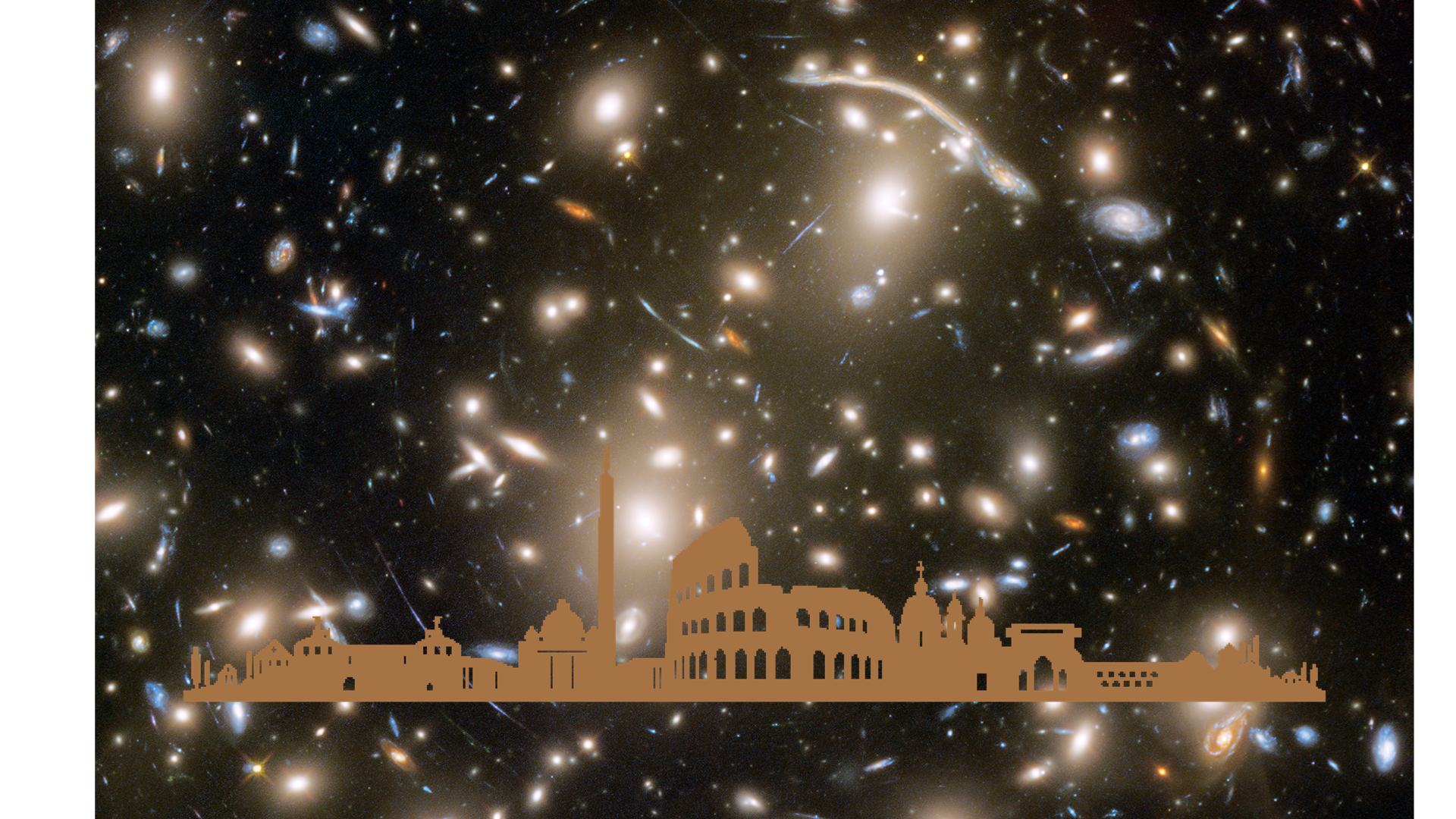
Left: BH mass function (MF) at z = 4, 6 and 8 predicted by CAT for a model where BHs grow from a dual population of light (magenta points) and heavy (red points) BH seeds forming as Pop III remnants (100 – 300 Msun) or by the collapse of super-massive stars (≈ 10^5 Msun). In this model, BH mass growth can not exceed the Eddington rate and this limits the growth of light seed, producing a mass gap in the MF (Trinca+2021). The results are compared with various empirical estimates of the BH MFs (green [106], violet [107], black [108]). The grey region at z = 8 shows the potential exploration range of JWST, that will be sensitive to growing heavy BH seeds at z > 6.
Right: time-dependent SED computed with CLOUDY of a heavy BH seed formed at z = 16.5 that grows to ≈ 1.5 10^7 Msun by z = 10. Black line with points show the sensitivity limits of NIRcam (triangles) and MIRI (squares) for a 10ks exposure. We also show hard/soft X-ray bands with cyan/yellow regions and the Athena (rectangle) and Lynx (horizontal line) sensitivity limits. The grey shaded area indicates the range where the emission is expected to be almost completely absorbed by the intervening neutral hydrogen (Valiante+18,21).
CAT will allow a fast exploration of a variety of models for the properties of AGN and galaxies in the first Gyr.
A consistent theoretical framework for the earliest phases of cosmic star formation must be well anchored to the observed properties of galaxies and AGNs in the post-reionization Universe (5 ≤ z ≤ 7) and compliant to the global constraints coming from current and future CMB and 21cm observations. To achieve these goals we need to describe structure formation in the first billion years of cosmic evolution following the hierarchical growth of dark matter halos, their stellar and gas content, and their nuclear black holes, over a wide range of masses, from the 106 Msun mini-halos hosting the collapse of the first stars at z = 20 – 30 to the largest galaxies that host powerful quasars at z = 5 – 7, likely hosted in halos with masses of 1012 – 1013 Msun.
This is still prohibitively expensive for cosmological hydrodynamic simulations, but can be achieved by reducing the size of the simulated volume or by employing the so called zoom-in techniques to a small number of pre-selected systems. An alternative approach is to use semi-analytical galaxy formation models (SAMs), where the evolution of the baryonic components of dark matter halos is modeled by invoking physically- and/or observationally-motivated prescriptions and the growth of dark matter halos is either constructed analytically or extracted from numerical simulations. In addition, SAMs have the flexibility to allow the exploration of still poorly constrained physical processes, such as the mass range and shape of the Pop III initial mass function, the nature of the first BH seeds, their dominant growth mode, and the feedback effects on their host galaxies.
Our group has led the development of two so far independent SAM:
– the first one, GAMETE/QSOdust runs on analytical dark matter halo merger trees and it is tailored to reproduce the properties of bright z = 6 quasars and their host galaxies (Valiante et al. 2011, 2014, 2016). The model has been successfully applied to investigate the co-evolution of the nuclear black hole and its host (Valiante et al. 2011, 2012, 2014), the relative importance of light and heavy black hole seeds and their observational signatures (Valiante et al. 2016, 2018a, 2018b), the incidence of super-Eddington accretion episodes in the black hole mass assembly of the first quasars and the implications on their observability (Pezzulli et al. 2016, 2017), the infrared luminosity of their progenitor galaxies (Ginolfi et al. 2019). These studies have enabled to explore the physical processes at work but have so far focused on z = 6 quasars that likely trace highly biased and over-dense regions that can not be considered as representative of the average galaxy population at z = 6.
– the second one, GAMESH, runs on numerical dark matter halos and couples the baryonic evolution with the radiative transfer code CRASH (Graziani et al. 2015). The advantage of the latter approach is that it allows to have full knowledge of the dynamical evolution and spatial distribution of the dark matter halos, enabling to follow the impact of inhomogeneous radiation fields and metal-rich bubbles on galaxy evolution. So far, GAMESH has been run on a small Local Group-like volume (4 h-1 Mpc)3 to explore the build-up of the Milky Way and its local satellites (Graziani et al. 2017, Ginolfi et al. 2018). The simulation has been coupled to binary population synthesis codes to predict the birth and merger rates of compact binary systems and of gravitational wave events similar to some of the events detected by the LIGO/VIRGO Collaboration (Schneider et al. 2017, Marassi et al. 2019, Graziani et al. in prep).
We are currently developing CAT (Cosmic Archaeology Tool) where we plan to integrate our two SAM into a single theoretical framework, with the unique capability of implementing the physics governing high-redshift star formation and black hole evolution under the influence of radiative and chemical feedback effects.
CAT will be first run on semi-analytical merger trees that are able to follow the mass growth of dark matter halos with a resolution mass of 106 Msun. This tool will incorporate all the necessary physical processes to make ab-initio predictions of galaxy and AGN statistical properties from z = 30 down to z = 5. In addition, it will be flexible enough to allow the exploration of different assumptions on the Pop III initial mass function, the nature of the first black hole seeds, their dominant growth mode, and their feedback effects on their host galaxies.
